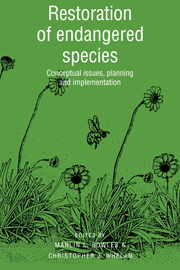Book contents
- Frontmatter
- Contents
- List of contributors
- Foreword
- Acknowledgments
- I Conceptual issues in restoration ecology
- 1 Organizational and managerial guidelines for endangered species restoration programs and recovery teams
- 2 Genetic considerations for plant population restoration and conservation
- 3 Managing genetic diversity in captive populations of animals
- 4 The relationship of rarity to plant reproductive biology
- 5 Experimental evidence for insect impact on populations of short-lived, perennial plants, and its application in restoration ecology
- II Restoration planning
- III Implemented restorations
- IV Synthesis and future directions: biology, politics and reality
- Taxonomic Index
- Subject Index
4 - The relationship of rarity to plant reproductive biology
Published online by Cambridge University Press: 27 January 2010
- Frontmatter
- Contents
- List of contributors
- Foreword
- Acknowledgments
- I Conceptual issues in restoration ecology
- 1 Organizational and managerial guidelines for endangered species restoration programs and recovery teams
- 2 Genetic considerations for plant population restoration and conservation
- 3 Managing genetic diversity in captive populations of animals
- 4 The relationship of rarity to plant reproductive biology
- 5 Experimental evidence for insect impact on populations of short-lived, perennial plants, and its application in restoration ecology
- II Restoration planning
- III Implemented restorations
- IV Synthesis and future directions: biology, politics and reality
- Taxonomic Index
- Subject Index
Summary
Introduction
Although many aspects of rarity have been studied, the relationship of plant reproductive biology and rarity is poorly understood. In this chapter, I will address this relationship, which is relevant to recent efforts to conserve rare plant species ex situ and to reintroduce rare species to habitats within their former ranges.
Reproductive systems in flowering plants are extraordinarily diverse. Unlike the majority of terrestrial animal species, which have separate female and male sexes, most flowering plants are hermaphroditic, producing male and female gametes in the same flower or in separate flowers on the same plant. Despite the potential for self-fertilization, diverse mechanisms have evolved that promote outcrossing, presumably to avoid the loss of fitness that often results from self-fertilization. Some of these mechanisms are spatial or temporal separation of pollen and stigmas; self-incompatibility, which prevents self-fertilization and matings among individuals possessing the same incompatibility type; and dioecy, or the separation of sexual function on different individuals (Table 4.1).
Outcrossing plant species depend on animals, wind, or water as pollen vectors. The degree of specialization of the pollen vector and the nature of the morphological and physiological adaptations of the plant species determine how effectively pollen is transferred among individuals of the same species. Some plant species have evolved adaptations for pollination by a very limited array of pollinators, although such specialization may be uncommon.
Many characteristics of plant reproductive systems may be associated with rarity.
- Type
- Chapter
- Information
- Restoration of Endangered SpeciesConceptual Issues, Planning and Implementation, pp. 90 - 117Publisher: Cambridge University PressPrint publication year: 1994
- 21
- Cited by



